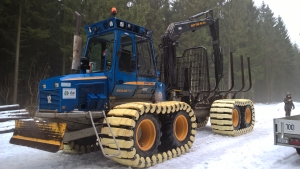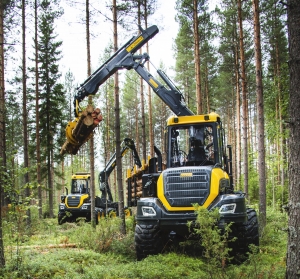Sustainable forest management and planning using digital terrain models: Part 1
In a three-part blog series, TECH4EFFECT examines some of the tools and results that were achieved across the project specifically aimed at reducing site impact. Part 1 highlights the importance of good planning to achieve sustainable management practices in a harvesting operation. It also briefly examines how online services to support requisitioning and marketing could be improved. Part 2 explains the TECH4EFFECT Depth-to-water maps which identify sensitive sites for environmental conservation. In the final, third blog, the T4E Mapping App is presented to demonstrate how ground surface modelling can be used in a practical harvesting operation.

Drones are essential to mapping environmental site impact with the aim of avoiding soil damage.
Correct forest management prevents soil damage
The preservation of forest soils and a well-functioning soil ecosystem is vital for a healthy and productive forest. Since machinery was deployed in timber harvesting operations, the potential damage to soil has been a controversial issue. This is why sustainable forest management practices are imperative to minimise soil impact.
With a predicted increase in mechanised harvesting operations across Europe to improve driver safety and efficiency, it is crucial that knowledge and technologies designed to improve soil protection are further developed. The dissemination of best practice in harvesting operations remains a high priority for the forestry sector.
In addition, soil compaction hampers gaseous exchange, which is necessary for vegetation growth and the preservation of the ecosystem. Correct forest management can prevent soil damage in the first place.

Bogie tracks cover wheels to minimise ruts. Courtesy NIBIO
Climate change causes harvesting re-think
Increasing temperatures due to climate change shorten the periods of suitable harvesting conditions due to less intensive frost, and partially increased precipitation. This is relevant in many European countries where harvesting used to be mainly carried out on frozen ground where heavy forest machines can drive on frozen, and therefore, solid soils.
Accordingly, forest actors have turned towards technology to find solutions to minimise site impact. All actors, including machine manufacturers, use and adopt the latest technological advances and innovations available, in terms of hardware configurations.
Examples of this are technical modifications like bogie-tracks, wider wheels with lower tyre pressure, winch assistance, and additional axles that can lessen the load of the heavy vehicle at the areas of impact to help reduce rutting.

Machine availability for a harvesting operation due to emergencies can be a challenge, at times. Courtesy Ponsse
Sustainable management practices
Besides technical innovations, a responsible and detailed planning of the harvesting operation, considering the soil characteristics (shear strength, bearing capacity, organic content, bedrock formations etc.) and weather conditions, is necessary to avoid severe rut formations.
However, an extensive planning of harvesting operations is time consuming, costly, and often simply not possible due to fast changing conditions like weather, market situations, or even pest infestations and other catastrophes, which need immediate attention.
Delivering the right hardware in terms of machine availability and suitability for a particular terrain can be a challenge. Downtime in getting there, covering large distances, is another. For the private forest owner, or smaller contractor, harvesting wood at the right time to optimise value is an additional consideration.

Precision forestry
This is where the idea of precision forestry becomes attractive. The concepts of open digital forests and the right timing of operations offering increased efficiency in production and supply chains becomes more manageable. Forest owners who live far away from their stands could use online services to access high-quality information to support decision making. For example, contracts and orders could be matched at an optimal time for sawmills, and for other local actors, in an attempt to increase planning horizons and production cover time to guarantee long-term supply.
Specifically, T4E examined the efficiency differences between similar supply chains with research focused on selected business processes between forest administrators, service providers, and local forest-based industries in Denmark, Finland and Norway. The results of these studies can be seen here in Deliverable 2.4 Business tools for improved stand treatment and wood mobilisation services.
The forestry industry, in general, has been more challenged and hence slower to react to Industry 4.0, which is defined as a digital transformation where machines and processes can be networked to optimise business intelligence to create value.
DTW maps to be examined in Part 2
In part two of the blog series, T4E will examine the tools used to reduce site impact, specifically the use of Depth-to-water maps.
Joachim Heppelmann, Marian Schönauer, Bruce Talbot and Philippa Webb-Muegge contributed to this blog.
This project has received funding from the Bio Based Industries Joint Undertaking under the European Union’s Horizon 2020 research and innovation programme under grant agreement No 720757.


